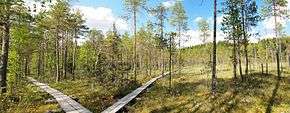Duckboards

A duckboard is a platform made of wooden slats built over muddy ground to form a dry passageway.
Hiking
Duckboards are used to allow hikers to safely pass moist areas of ground, such as a swamp or shores of a lake. Specially wide duckboards are often used to provide wheelchair access. Duckboards are nailed into the end of their support logs, with wooden stakes.
World War I

During World War I, duckboards were used to line the bottom of trenches on the Western Front, as these were regularly flooded, [1] and mud and water would lie in the trenches for months on end. The boards helped to keep the soldiers' feet dry and prevent the development of trench foot, caused by prolonged standing in waterlogged conditions. They also allowed for troops' easier movement through the trench systems. In the Ypres Salient, duckboards were laid at ground level to help soldiers advance to the front lines.
Combat troops on nearly all sides routinely wore hobnail style "Trench Boots" that often slipped on the new duck boards when they were wet, and required extra caution. Falling or slipping off the duckboards could often be dangerous, even fatal. Unfortunate soldiers were left struggling to rise under the weight of their equipment in the intractable and sometimes deep water/mud. If this happened at ground level during a tactical advance, the rising soldier could be left a defenseless target for enemy fire as well as hinder forward progress. He could also simply go unnoticed in the ensuing melee, and easily drown under his heavy equipment.
Use in industry
Used in factories with concrete floors, wooden duckboards provide a comfortable platform for workers who stand in one place, such as lathe operators. The flex of wood is easier on the legs than concrete, when working a shift.
See also
- Boardwalk
- Corduroy road
- Marsden Matting - a 20th-century equivalent for airport runways
- Plank road
- Sweet Track and Post Track
- Timber trackway
References
External links
-
 Media related to Duckboards at Wikimedia Commons
Media related to Duckboards at Wikimedia Commons
_et_caillebotis_de_La_Vecqu%C3%A9e_(4).jpg)